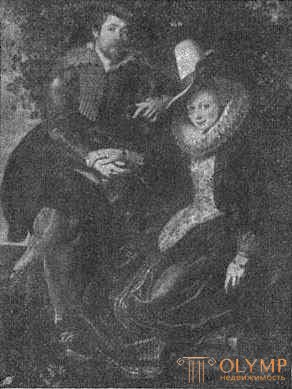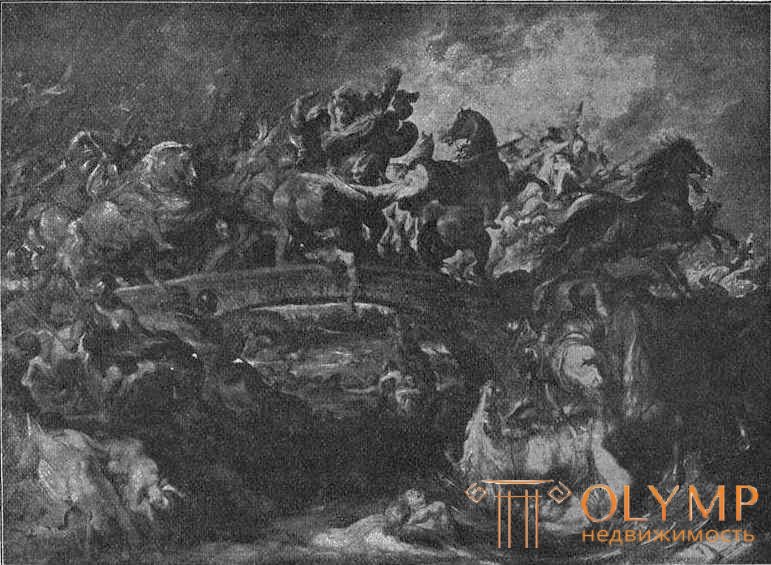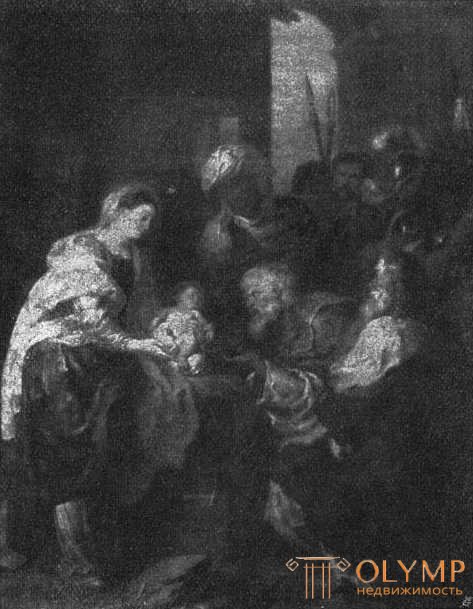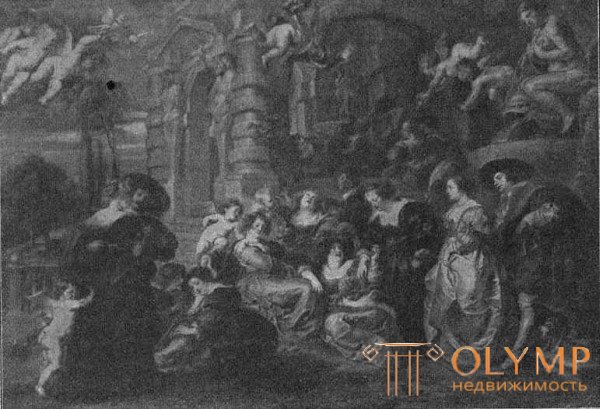
1. Belgian painting in the early period
In the Belgian painting of the period, national distinctive features are more noticeable than in architecture and in sculpture. At the first stage, the most common is gravure painting, which uses a significant variety of subjects: religious, mythological, household. Antwerp becomes the dominant center for the development of painting.
More diverse and colorful than Flemish architecture and sculpture, Flemish painting of the 17th century unfolds in its lush bloom. Even more clearly than in these arts, the ever-Flemish mixture of the northern and southern foundations, as an indestructible national treasure, emerges here. Modern art in them in one country did not capture such a rich and variegated area of plots. In the new or restored churches, hundreds of gigantic baroque altars awaited images of saints painted on large canvases. In the palaces and houses the vast walls yearned for mythological, allegorical or genre easel paintings; Yes, and portrait painting, which developed in the XVI century before the portrait in natural growth, remained a great art in the full sense of the word, combining fascinating naturalness with the nobility of expression.
Next to this large painting, which Belgium shared with Italy and France, flourished here, continuing the old traditions, original cabinet painting mostly on small wooden or copper boards, unusually rich, embracing everything that was depicted, without neglecting religious, mythological or allegorical subjects, preferring everyday life of all classes of the population, especially peasants, cab drivers, soldiers, hunters and sailors in all its manifestations. Designed landscape or room backgrounds of these small-figure paintings were transformed into independent landscape and architectural paintings in the hands of some masters. Images of flowers, fruits and animals complete this series. Overseas trade delivered to the kennels and zoos of the ruling archdukes in Brussels the wonders of the flora and fauna. The wealth of forms and colors they could not lose sight of the artists who have mastered everything.
For all that, in Belgium there was no longer any ground for monumental wall painting. With the exception of Rubens' paintings in the Antwerp Jesuit Church and a few ecclesiastical series of landscapes, the great masters of Belgium created their large, canvas, wall and ceiling paintings for foreign rulers, and the fall of the Brussels tapestry technique, which Rubens’s participation reported only temporary lifting, made participation unnecessary other Belgian masters, what are the Jordaans and Teniers. But the Belgian masters took the famous, though not as deep as the Dutch, participation in the further development of engraving and etching. Dutch natives were even the best engravers before Rubens, and the participation of the greatest Belgian painters: Rubens, Jordans, van Dyck, Brouwer and Teniers in “pictorial engraving” - etching, is partly only a side affair, partly even doubtful.
Antwerp, a rich Low German trading town on the Scheldt, has now become more than ever, in the full sense of the word, the capital of Low-Dutch painting. Brussels painting, unless it was in the landscape that sought independent paths, became a branch of Antwerp art; even the painting of the old Flemish centers of art, Bruges, Ghent and Mecheln, lived at first only by its relationship to the Antwerp workshops. But in the Walloon part of Belgium, precisely in Luttych, one can trace an independent aggression towards the Italians and the French.
For the general history of the 17th century Flemish paintings are important, in addition to the collections of literary sources by van Mander, Goubraken, de Bee, van Gool and Weiermann, Immerzel, Kramm and Wurzbach's vocabulary, combined, only partly outdated, books by Mihiels, Vaagen, Waters, Riegel and Philippi . In view of the prevailing importance of the art of Scheldt, one can also call the history of the Antwerp art of van den Branden and Rooses, requiring, of course, additions and changes. The relevant chapter of the author of this book in his and Voltman "History of Painting" is already outdated in detail.
The complete freedom of pictorial location and execution, the internal unity of drawing and paints, the smoothest breadth and power of the 17th century Flemish painting reached in the creative hands of its great master Peter Paul Rubens, who made Antwerp the centerpiece of painting for all of Europe. There was no shortage, however, in the masters who stood at the transition between the old and the new directions.
The influence of older paintings by Brill affects the second son of Peter Bruegel the Elder, Jan Bruegel the Elder (1568–1625), before his return to Antwerp, in 1596, who worked in Rome and Milan. Crivelli and Michel dedicated separate works to him. He wrote mostly small, sometimes miniature pictures, giving the impression of a landscape, even in cases where they present biblical, allegorical or genre themes. It is they who firmly hold Koninkloo style with bunched foliage, although they transfer the mutual transitions of three backgrounds more subtlely. It is characteristic of the versatility of Jan Bruegel that he painted landscape backgrounds for figure painters like Balen, figures for landscape painters like Momper, flower wreaths for artists such as Rubens. It is known for its freshly and subtly performed “The Fall of Man” of the Hague Museum, in which Rubens wrote Adam and Eve, and Jan Bruegel the landscape and animals. His own landscapes, abundantly equipped with colorful folk life, still not expressively expressing the sky with its clouds, present mainly hilly terrain irrigated by rivers, plains with windmills, village streets with tavern scenes, canals with wooded banks, lively country lanes on wooded heights and wooded roads with lumberjacks and hunters, alive and faithfully observed. Early pictures of his brush can be seen in Milan Ambrosians. It’s richer in Madrid, well in Munich, Dresden, Petersburg and Paris. Of particular importance in the sense of finding new ways was his painting of flowers, highly convincingly conveying not only the beauty of the forms and the brightness of the colors of rare colors, but also their combinations. Madrid, Vienna and Berlin have pictures of the colors of his brush.
Of his employees, we must not miss Gendrick van Balen (1575–1632), whose teacher is considered to be Rubens’s second teacher, Adam van Noort. His altar paintings (for example, in the church of James in Antwerp) are unbearable. He became famous for his small, smoothly painted, sugary paintings on boards with content mainly from ancient fables, such as “Feast of the Gods” in the Louvre, “Ariadne” in Dresden, “Manna Collection” in Braunschweig, but his paintings of this kind also lack artistic freshness and immediacy.
The landscape style of the transitional period described above lasted, however, among weak imitators until the beginning of the 18th century. Here we can mark only the strongest masters of this trend, who transferred it to Holland, David Vinkboons from Mecheln (1578–1629), who moved from Antwerp to Amsterdam, wrote fresh forest and village scenes, and occasionally also biblical episodes in a landscape setting, but more readily temple Holidays in front of village pubs. His best paintings in Augsburg, Hamburg, Braunschweig, Munich, St. Petersburg are quite directly observed and are painted with flowery colors, not without force. Relant Savery from Kurtra (1576–1639), to whom Kurt Erasmus devotedly wrote a study with love, studied German wooded mountains in the service of Rudolf II, after which he settled as a painter and etcher, first in Amsterdam, then in Utrecht. His light-filled, gradually merging the three plans, but somewhat dry in execution, mountain, rocky and forest landscapes, which can be well acquainted in Vienna and Dresden, he equip living groups of wild and tame animals in scenes of hunting, in the images of paradise and Orpheus. He also belongs to the earliest independent painters of colors. Adam Villaerts from Antwerp (1577, died after 1649), who moved to Utrecht in 1611, was a representative of the seascape of this transitional style. Its coastal and marine views (for example, in Dresden, at Weber in Hamburg, in the gallery of Liechtenstein) are still dry in the pattern of the waves, still coarse in depicting ship life, but are captivating with the honesty of their attitude to nature. Finally, Alexander Kerrinks from Antwerp (1600–1652), who transferred his Flemish landscape art to Amsterdam, in the paintings with his signature still follows Koninkslo, but in later paintings by Braunschweig and Dresden, is obviously influenced by brownish Dutch tonal painting by Van Goyen . He thus belongs to the transitional masters in the fullest sense of the word.
Of the Antwerp masters of this style who stayed at home, Sebastian Vranks (1573–1647) reveals undoubted success as a landscape painter and painter of horses. He also depicts foliage in the form of bunches, most often hanging like a birch, but he gives her a more natural connection, gives a clear tone to the airy tone and knows how to communicate the vital character of the actions of confidently and coherently written horses and riders of their battle and predatory scenes that can be seen For example, in Brunswick, Aschaffenburg, Rotterdam and Weber in Hamburg.
Finally, in architectural painting as early as the 16th century, he developed a transitional style along the paths of Steenwick the Elder, consisting in the gradual replacement of the literal nature following the artistic charm of his son, Hendrik Steenwick Junior (1580–1649), who moved to London, and next to him, Peter Neufs the Elder (1578–1656), whose interior views of churches can be found in Dresden, Madrid, Paris and Petersburg.
2. Rubens contribution to Belgian art
Peter Paul Rubens is considered the greatest artist of both Belgium and the whole world. It was he who formed the image of national painting, setting the direction of development for his students and followers. Like most other artists, Rubens began his creative career from studying in Italy; on returning home, he became the court painter of the ruling house.
At the head of the latest literature on Rubens is the widely conceived collection work of Max Rooses: “Works of Rubens” (“Loeuvre de Rubens” (1887–1892). The best and most important biographical works belong to Rooses and Michel. Summary works, after Vaagen, published also by Jacob Burchardt , Robert Fischer, Adolf Rosenberg and Wilhelm Bode. Some questions about Rubens dealt with Ruelens, Voltmann, Riegel, Göler von Ravensburg, Grosman, Riemans, and others. Rubens, as an engraver, was engaged in Himans and Forogelm-Schnefogt.
Rubens was born in Siegen, near Cologne, from respected Antwerps and received his first artistic education in the city of his fathers from Tobias Vergegta (1561–1631), a mediocre landscape painter of transitional style, then studied for four years with Adam van Noort (1562–1641), as is now known, one of the middle masters of the mannered italism, and then worked for another four years with Otto van Veen, rich in fabrication, empty in the forms of a false classic, to whom he first closely joined and in 1598 became a shop master. Three teachers Rubens Gaberditsl dedicated extensive articles in 1908. It is impossible to establish with certainty any picture of the early Antwerp period of Rubens. From 1600 to 1608 he lived in Italy; first in Venice, then mainly in the service of Vincenzo Gonzaga in Mantua. But already in 1601, he wrote in Rome for the three altars of the Church of Santa Croce in Jerusalem "The Acquisition of the Cross", "The Crown of Thorns" and the "Exaltation of the Cross". These three paintings, now belonging to the chapel of a hospital in Grasse, in southern France, are still found by self-seeking, still influenced by copies from Tintoretto, Titian and Correggio, but already filled with an independent desire for strength and movement, the style of his first Italian period. A young master went to Spain with a commission from his prince in 1603. Из написанных им там картин фигуры философов Гераклита, Демокрита и Архимеда в мадридском музее обнаруживают еще напыщенные, несамостоятельные формы, но и сильное влечение к психологической глубине. Вернувшись в Мантую, Рубенс написал большой трехчастный алтарный образ, средняя картина которого, с поклонением семьи Гонзага св. Троице, сохранилась в двух частях в мантуанской библиотеке, а из широких, обильных фигурами боковых картин, показывающих все растущую силу форм и действия масс, «Крещение Христа» попало в антверпенский музей и «Преображение» в музей Нанси. Затем в 1606 г. мастер снова написал в Риме для Кьеза Нуова великолепный, уже исполненный рубенсовской мощи в своих залитых светом фигурах, запрестольный образ «Успения св. Григория», принадлежащий ныне гренобльскому музею, а в Риме замещенный уже в 1608 г. тремя другими, ничуть не лучшими картинами того же мастера. Яснее напоминает манеру Караваджо эффектное «Обрезание Христа» 1607 г. в Сант Амброджо в Генуе. Впрочем, такие исследователи, как Роозес и Розенберг, относят к итальянскому периоду мастера, когда он копировал произведения Тициана, Тинторетто, Корреджо, Караваджо, Леонардо, Микеланджело и Рафаэля, еще ряд картин его кисти, по-видимому, однако, написанных позднее. Большие, происходящие из Мантуи, сильные по формам и краскам, аллегории порока и добродетели в Дрездене, если и не написаны, как думает вместе с нами Михель, около 1608 г. в Мантуе, то мы скорее допускаем вместе с Боде, что они явились по возвращении Рубенса на родину, чем с Роозесом, что они написаны до его итальянского путешествия в Антверпен. Уверенно рисованный и пластично моделированный образ Иеронима в Дрездене также обнаруживает своеобразную рубенсовскую манеру, быть может, даже слишком выработанную для его итальянского периода, к которому мы и теперь относим эту картину. По возвращении Рубенса в 1608 г. в Антверпен, уже в 1609 г. он был назначен придворным живописцем Альбрехта и Изабеллы, а его стиль, уже самостоятельный, быстро развился до грандиозной силы и величия.
Cluttered in composition, restless in shape, uneven in light effects is his “Adoration of the Magi” (1609–1610) in Madrid, marked, however, by a powerful movement. Full of life and passion, mighty in muscular body styling his famous three-part image of the “Exaltation of the Cross” in the Antwerp cathedral. Stronger Italian memories are reflected in simultaneous mythological paintings, such as Venus, Cupid, Bacchus and Ceres in Kassel, and the plump, bound Prometheus in Oldenburg. The typical portraits of the large size of this epoch are the landscaped portraits of Albrecht and Isabella in Madrid and the magnificent Munich picture representing in the gazebo of the master's honeysuckle with his young wife, Isabella Brant, brought to his homeland in 1609, an incomparable image of calm pure happiness love

Fig. 148. Self-portrait of Rubens with his wife Isabella Brant, in the Pinakothek in Munich. From the photograph of F. Brookman in Munich
Further flight art of Rubens discovered between 1611 and 1614. The huge picture of "Removing the Cross" with the majestic "Visit of Mary Elizabeth" and "Entry into the Temple" on the doors, in the Antwerp Cathedral, is considered the first work in which the master brought to full development their types and their way of writing. Wonderful passionate vitality of individual movements, even more wonderful is the heartfelt power of pictorial execution. Mythological paintings like “Romulus and Rem” in the Capitoline Gallery, “Faun and Faun” in the Schönborn Gallery in Vienna also belong to these years.
3. The heyday of creativity Rubens and his legacy
At the height of Rubens' creativity, his popularity is extremely high. To fulfill a huge number of orders, he uses the help of students, which include Bruegel, Snyders, Wildens, Van Dyck - the future outstanding masters. After himself, Rubens left more than two thousand paintings that became the property of many countries.

Fig. 149. "Battle of the Amazons" in the Munich Pinakothek. From the photograph of F. Brookman in Munich
Clearly, stately, powerfully, finally, portraits of Rubens of this five-year period. The masterpiece is his self-portrait in the Uffizi, his portrait group “The Four Philosophers” in Palazzo Pitti is magnificent. In the prime of his beauty is his wife Isabella in the noble portraits of Berlin and The Hague. Around 1620, the portrait of Susanna Furman in a hat with a feather in the National Gallery in London was also written by an amazing, fanned with the most tender light and shade. Famous male portraits of the master of these years can be seen in Munich and in the gallery of Liechtenstein. As passionately as Rubens depicted episodes from Sacred World History, hunting scenes and even landscapes, he wrote his portrait figures as calmly as he could, transferring their body shell with monumental power and truth, but not trying to spiritualize internally, seized only in general, facial features. Van Dyck left Rubens in 1620, and his wife Isabella Brant died in 1626. A new impetus for his art was a secondary marriage to the young, beautiful Elena Furman, in 1630. However, his artistic and diplomatic trips to Paris also served as an impetus. (1622, 1623, 1625), to Madrid (1628, 1629) and to London (1629, 1630). Of the two large historical episodes with allegories, 21 huge paintings from the life of Marie de Medici (Grosman wrote their history) now belong to the best decorations of the Louvre. Scribed by the workshop with Rubens’s hand, painted by his students, finished by him, these historical paintings are filled with many modern portraits and allegorical mythological figures in the spirit of modern baroque and represent such a mass of individual beauties and such artistic harmony that they will forever remain the best works of painting of the XVII century. From a series of paintings of the life of Henry IV of France, two half-finished fell into the Uffizi; sketches for others are stored in different collections. Nine paintings glorifying James I of English, with which Rubens, after a few years, decorated the plafond fields of the state hall at White Hall, blackened by soot from London, are unrecognizable, but they themselves do not belong to the master's most successful works.

Fig. 150. "The Adoration of the Magi." Rubens painting in the Louvre. From the photo of F. Ganfshtengl in Munich
The last decade that fell to the lot of Rubens (1631–1640) stood under the star of his beloved second wife Elena Furman, whom he painted in all forms and which served him in kind for religious and mythological paintings. Her best portraits of Rubens' brush belong to the most beautiful female portraits in the world: half-length, in a rich dress, wearing a hat with a feather, life-size, sitting, in a luxurious dress open on her chest, in small form, next to her husband for a walk in the garden - she is in the Munich Pinakothek; naked, only partly covered by a fur gown, in the Vienna Court Museum; in a suit for walking in a field in the Hermitage; with his firstborn on the piss, arm in arm with her husband, and also on the street, accompanied by a page, at Baron Alfons Rothschild in Paris.
The most significant church works of this flourishing, radiant late master epoch are majestic and calm in composition, shining with all the colors of the rainbow, the altar of St.. Ildefons with powerful figures of donors on the doors of the Vienna Museum of the Court and a magnificent altarpiece in his own tomb of Rubens in the Church of James in Antwerp, with the saints of the city, written with people close to the master. More simple works, such as: of sv. Cecilia in Berlin and lush Beersheba in Dresden are not inferior to them in color and tone. The precious mythological paintings of this period belong to the brilliant courts of Paris in London and Madrid; and what passionate vitality breathes the hunt of Diana in Berlin, how fabulously luxurious is the festival of Venus in Vienna, with what magical light illuminated Orpheus and Eurydice in Madrid!
Preparatory for this kind of paintings are some genre images of the master. Thus, the character of the mythological genre captured boldly sensual, full-size, "Hour Dating" in Munich.

Fig. 151. "The Garden of Love." Rubens painting in Madrid. From the photo of F. Ganfshtengl in Munich
Most of these landscapes of Rubens also belong to the last years of his life: such is the shining landscape with Odyssey in the Pitti Palace, these are new in design landscapes, artistically explaining the flat terrain in which the Rubens dacha was located, and with a majestic, full of mood transmission sky changes. The most beautiful are the fiery sunset in London and landscapes with a rainbow in Munich and St. Petersburg.
For whatever Rubens took, he turned everything into glittering gold; and the one who came in contact with his art, as an employee or a follower, could not escape from his vicious circle.
4. Van Dyke: Early Creativity
Anton Van Dyck was the most significant figure among Rubens' students. Like other artists, he began his career in Italy, after which he worked with Rubens. His early works are in many ways close to the style of his teacher. Van Dyke mainly painted on religious themes, as well as portraits of historical figures.
Of the many students of Rubens, only Anton van Dyck (1599–1641) - whose light, of course, refers to the light of Rubens, like the moon’s to the sun’s, reaches the heavens of art with a brilliantly-lit head. Although Balen is considered to be his real teacher, Rubens himself called him his student. In any case, his youthful development, as far as we know, was influenced by Rubens, from whom he never completely retreats, but, according to his more impressionable temperament, he processes into a more nervous, delicate and subtle painting style and less powerful in drawing style. Long-term stay in Italy finally turned him into a painter and painter. It was not his business to invent and dramatically exacerbate live action, but he knew how to put figures in well-thought-out relations to each other in his historical paintings and to inform his portraits of such subtle features of social status that he became the favorite painter of nobles of his time. The latest consolidated work on van Dyck belong to Michiels, Giffrey, Bush and Schaeffer. Separate pages of his life and art explained Vibiral, Bode, Himans, Rooses, Lau, Menotti and the author of this book. Even now they are arguing about the distinction between different periods of life time, which were connected mainly with traveling. According to the latest research, he worked until 1620 in Antwerp, in 1620–1621 in London, in 1621–1627 in Italy, mainly in Genoa, with a break from 1622 to 1623, conducted, as Rooses showed, in his homeland, in 1627 –1628 in Holland, then again in Antwerp, and from 1632 as court painter Charles I in London, where he died in 1641, and during this period, in 1634–1635 he was in Brussels, in 6140 and 1641 in Antwerp and Paris.
Что бы оставить комментарий войдите
Комментарии (0)